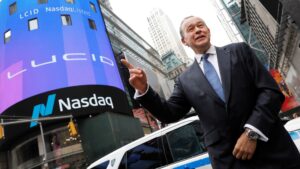Lucid Motors Faces Leadership Shake-Up Amid Market Concerns: What Lies Ahead?
In the dynamic world of electric vehicles (EVs), Lucid Motors (Nasdaq: LCID) has recently experienced a significant shake-up that has investors on edge. The sudden departure of CEO Peter Rawlinson, a pivotal figure in the company’s journey since it went public through a merger with Churchill Capital Corp IV, sent shares tumbling by more than 10%. With Rawlinson stepping down and the appointment of interim CEO Marc Winterhoff, the future trajectory of this innovative automaker is sparking heated discussion across Wall Street and among enthusiasts alike.
A Leadership Interim with Heavy Expectations
Rawlinson wasn’t just a CEO; he was the heart and soul of Lucid Motors. His vision and leadership led the company through its critical phases, including the strategic decision to list on the Nasdaq. Analysts like John Murphy from Bank of America emphasize the gravity of his exit, pointing to potential stagnation in product development and a risk to future funding opportunities. The investor community is understandably apprehensive, given the priority surrounding the establishment of a strong leadership team in a fast-evolving sector.
Looking forward, interim CEO Marc Winterhoff aims to stabilize the ship. In a recent CNBC interview, he expressed commitment to building on Lucid’s existing successes rather than drastically altering its course. "We have a clear vision," Winterhoff stated, underscoring that his focus will be on execution, which is precarious during a time of uncertainty.
Navigating Financial Waters
While Lucid continues its path towards profitability, it remains in a challenging financial position. The company reported a staggering net loss of $636.9 million for the fourth quarter, reflecting the ongoing costs involved in scaling production. However, there’s a silver lining—Lucid is progressively narrowing its gross losses, with improvements noted in its GAAP gross margins from a disconcerting negative 225% in 2023 to negative 114% in 2024. This gradual enhancement indicates that their strategies may be paying off, albeit slowly.
Winterhoff, echoing sentiments from the conference call, remains optimistic about improving gross margins as production ramps up. Interestingly, Lucid’s unique positioning as a high-end EV producer means it faces niche competition, and as it strives to enhance customer awareness, it may also need to refine its marketing strategies.
Upcoming Products: The Road Ahead
As Lucid looks toward its future, it maintains its production of the Air sedan while gearing up for the launch of the much-anticipated Gravity SUV. Winterhoff has highlighted that the Gravity will significantly contribute to the company’s 20,000-unit production target, with initial customer orders already kicked off in Saudi Arabia. Such developments are crucial as Lucid navigates the competitive EV landscape dominated by companies like Tesla and Rivian.
Moreover, Lucid is working on a new midsize vehicle platform expected to debut by the end of 2026. Both Winterhoff and Rawlinson regarded this launch as essential to achieving substantial growth, suggesting that Lucid’s ambition extends beyond immediate challenges.
Marketing Matters: Returning to the Spotlight
In light of increasing production and a broadened vehicle lineup, Winterhoff emphasizes the need to enhance marketing efforts. As he stated, "We’re going to double down on marketing," a strategy vital to elevating brand awareness and facilitating customer reach. The previous stronghold established by Rawlinson will now be fortified through heightened advertising after years of perseverance in gaining market traction.
Embracing Innovation: Tech Developments and Partnerships
Despite Lucid’s shortcomings in advanced driver-assistant technologies compared to competitors like Tesla and General Motors, the company boasts exceptional battery efficiency, a key selling point in today’s market. Lucid’s upcoming hands-free driving system, set to debut later this year, might help bridge the gap with competitor offerings.
Additionally, in a bid to leverage its tech position, Lucid is exploring partnerships that could allow other companies to utilize its cutting-edge battery technologies, thus creating new revenue streams. With Winterhoff at the helm, the ongoing discourse regarding potential collaborations could redefine how Lucid navigates the element of technological leadership in the evolving EV market.
Conclusion: The Road Ahead for Lucid Motors
As we observe the unfolding situation at Lucid Motors, the combination of leadership transitions, financial hurdles, and product innovations paints a complex picture. For consumers and investors alike, it is a moment of both challenge and opportunity. While uncertainty looms, the foundation laid by Rawlinson and the vision expressed by Winterhoff may provide clues about Lucid’s capacity to adapt and thrive in the fierce automotive landscape.
At Extreme Investor Network, we’ll continue to monitor Lucid’s progress closely and provide insights on emerging trends, making sure you’re always ahead in the investment game. Stay tuned as we delve deeper into the innovations and market strategies shaping the future of electric vehicles.

